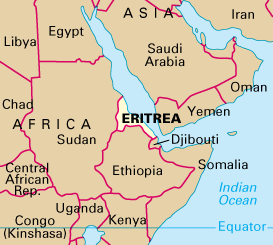The escalating asylum seeker crisis in Europe has prompted heated debates. European authorities are clearly not sure how to handle the influx of people onto the continent. Many of the people attempting to enter Europe are fleeing countries in the Middle East and North Africa. The mounting refugee problem in Europe—often seen as a result of the Syrian war—has attracted the attention of the world’s media. But there is another, often forgotten, dimension to the crisis which has been on going for a number of years: the political instability in North Africa, Eritrea specifically.
Many people fleeing North Africa are Eritreans. They are fleeing a police state situated on the Red Sea with Sudan on the west, Ethiopia on the south and Djibouti in the southeast as neighbours. Modern-day Eritrea was formed as a result of an incorporation of independent kingdoms and sultanates as well as various north Ethiopian vassal states of the Ethiopian and Ottoman Empires. This eventually resulted in the formation of Italian Eritrea. In 1947 Eritrea became part of a federation with Ethiopia – the federation of Ethiopia and Eritrea. Annexation into Ethiopia led to the Eritrean War of Independence fought from 1961-1991. In 1993, after a referendum, Eritrea became independent.
Peace was short-lived. Between 1998-2000 Eritrea fought a renewed border war with Ethiopia that left an estimated 80,000 people dead. An international court awarded the flashpoint frontier town of Badme to Eritrea, but the Ethiopians refused to withdraw fuelling further tensions. Eritrea, it’s believed, shipped guns to other regional rebels to needle Ethiopia.
Life for Eritreans deteriorated sharply in 2000. Isaias Afwerki, heroic freedom fighter who has been president since independence in 1993 and now rules the country with an iron fist, lost the Eritrean-Ethiopian war. He wanted to reassert his power and so begun a policy of indefinite conscription. Police, apparently, prowl the streets looking for those trying to avoid conscription, if caught crippling fines or imprisonment are imposed. Afwerki has also shut down the press and arrested dissidents. Opposition figures are jailed and the state media often warn of an imminent Ethiopian attack, perhaps a tactic to keep Eritreans subservient to Afwerki.
Born in 1946 in Asmara into an Orthodox Christian family, he moved to the Ethiopian Capital—Addis Ababa—to study engineering. At the age of 20 he left to join a separatist movement fighting for Eritrean independence. Afwerki rose through the ranks to command a well-organised movement whose guerrillas dug a warren of bunkers to hold out against Ethiopian fighter jets. Asmara was liberated in 1991 and an overwhelming vote for independence was held in a referendum in 1993.
Afwerki was initially backed by the United States and Soviet Union. Eritrea was once held up as a beacon of hope for Africa by Western powers. Former US president, Bill Clinton, hailed him as a “renaissance leader.” Now Afwerki ignores criticism and shrugs off international condemnation. He has expelled international aid agencies and a United Nations (UN) peacekeeping force. He closed down independent media and jailed critical journalists. Eritrea has dropped below North Korea as the world’s worst nation for press freedom; according to rights group “Reporters without Borders.” The economy has stagnated; army generals run thriving networks of corrupt businesses and cream off lucrative profits.
There are reports that religious minorities—including evangelical Christians—are jailed in appalling conditions (often in shipping containers in the baking heat). Afwerki believes that their presence is a foreign plot to divide a nation that is officially split equally between Christian and Muslim.
Eritreans now take enormous risks trying to flee their country and the tyranny of Afwerki. Border guards have a shoot-to-kill policy. Kidnapping is also common on the Sudanese border and Eritreans are captured and taken to the Sinai Peninsula and held for ransom in prisons.
The first wave of Eritreans fled their native land in 2003. The government polices the borders, controls movements (even in neighborhoods) and keeps tabs on the population with an integrated network of “mosquitoes.” Like so many who heroically struggle for freedom in Africa, Afwerki is yet another example of an African leader who went from acclaimed freedom fighter to iron-fisted dictator. Once he used to stroll down the evening streets of the mountain capital, Asmara, with its Italian-era colonial architecture and pop in to bars for a drink. He was, and cultivated, the image: “man of the people.” Leaked US diplomatic cables now call him “isolated and mercurial… an unhinged dictator.”
To add to the woes of Eritreans a rumour circulated during the Arab Spring: their country sent mercenaries to support former Libyan dictator Muammar Gaddafi. Eritreans claim that, since then, militias have been targeting them. Militia put captives into Libyan prisons—many Eritreans try to flee through Libya. There are reports that the Islamic State Group are targeting Eritrean migrants—many of whom are Christian. In April, this year, the group published a video showing the beheadings of Ethiopian and Eritrean migrants. In June a further 86 Eritreans were kidnapped and two killed.
Eritreans are the third-largest number of people leaving North Africa for Europe. The U.N. believes that about 5000 flee a month. Many are also leaving refugee camps in Sudan and Ethiopia in which they were placed. They are frustrated and tired of waiting for resettlement paperwork to be done, claims Amanuel Ghirmai—a Paris-based journalist working at Radio Erena. Eritreans flee to any place they can, risking perilous journeys in the hope of some sort of future that is better than their present hell. They, like others fleeing horrendous conditions in countries in North Africa, cross the Mediterranean hoping to get into Greece, Italy, France, Spain—or any country which may offer them a better future.
Many Eritrean refugees cross France to get to the UK, Germany and Nordic States. A number have settled in Paris—France has shown some hospitality and many have been allowed to stay. The number of Eritreans who travel through France annually to attempt passage to other countries, like the UK, is however, bigger than the number who seek domicile in France.
Early last week South African president, Jacob Zuma, launched a blistering attack on the North Atlantic Treaty Organisation (NATO) members saying that their intervention in Libya in which they removed Muammar Gaddafi contributed to the problem. “It was the actions taken against Mr Gaddafi that totally undermined security in Libya and opened the floodgates of refugees,” Zuma said. He said that this came at a time when Africa had a roadmap for resolving the situation in Libya. It was the responsibility of the European countries that were involved in Libya to accept refugees “because they caused it”. Zuma also said that closing European borders was not the answer to resolving the current crisis.
While Zuma might be correct in saying that closing borders will not solve the problem, he is mistaken to suggest that Africa had a roadmap for solving the crisis - if history is anything to go by. African leaders, for many years, have been unable to deal with despots and dictators on the continent. Often the African Union (AU) is considered to be ineffectual and toothless. The fact that, currently, Zimbabwean president, Robert Mugabe, is chair of the AU (the chair rotates) further affirms this negative view of the AU. While the west, it seems, must take some responsibility for the current refugee crisis, African leaders cannot be absolved of their responsibility of omission and commission; Eritrea is a good example of the failure of the west and Africa.
Sadly, while European and African leaders talk (mostly) about the escalating crisis, thousands of people risk their lives, lose their families and watch their children drown as they desperately seek a life worth living.
That’s the sad unforgivable reality.








